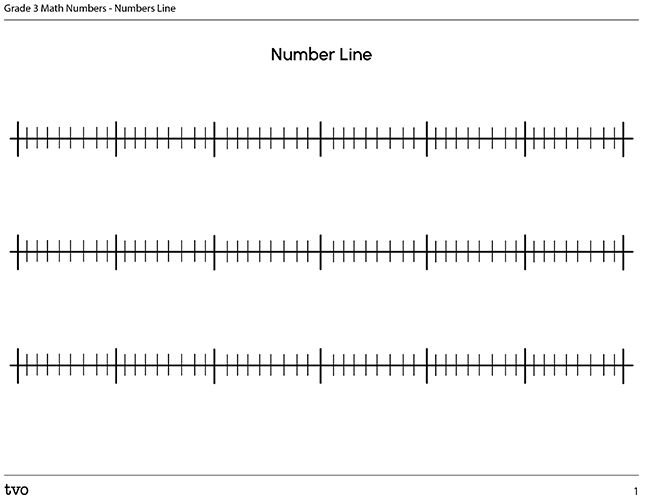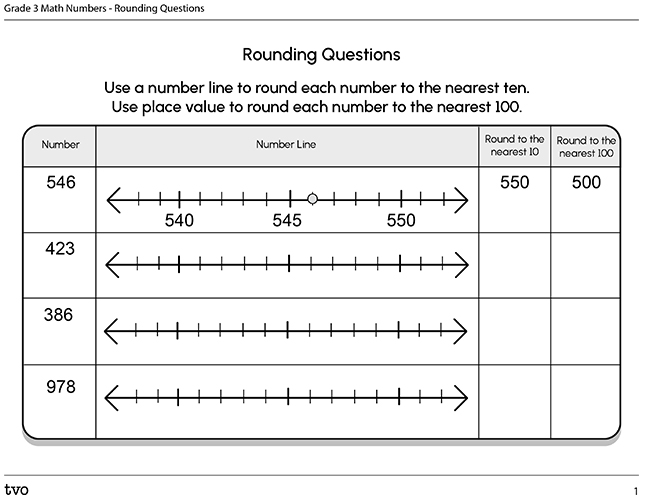Minds On
Exploring numbers

Examine the following numbers: 3 and 8
How can you use these two digits to make the largest number?
How can you use these two digits to make the smallest number?
Action
Tracking what we read
Mila is keeping track of all the books they read and the number of pages in each book. Here is Mila's list for the month of April.
How Can I See the Stars–125 pages
Who is Upstairs?–78 pages
Where is Sam?–236 pages
The Lone Deer–45 pages
On My Way–313 pages
My Canoe on the River–116 pages

Comparing, ordering and rounding numbers
We can compare, order and round numbers using different strategies:
- Base ten blocks
- Number lines
- Place value
Base Ten Blocks
We can compare the value of numbers using base ten blocks. For example, we can compare the number of pages in the book “How I See the Stars” (125 pages) and “My Canoe on the River” (116 pages).
To compare and order numbers using base ten blocks
- model each number using flats, rods and singles
- compare the values in the hundreds, tens and ones columns
Student Success
Think-Pair-Share
Let’s compare the numbers.
Share your ideas in your notebook.
 Description
Description
A table with columns A and B. Each column shows two numbers made of blocks. The first number in column A is made of 1 hundred block, 3 ten blocks and 2 one blocks. The second number in column A is made of 2 hundreds blocks, 1 ten block and 3 ones blocks. In column B, the first number is made using 4 ten blocks and 1 ones block. The second number in column B is made using 1 hundreds block and 4 ones blocks.
Note to teachers: See your teacher guide for collaboration tools, ideas and suggestions.
Number Lines
We can also use a number line to compare and order numbers.
What is the missing number?

Start on a number you know and count on.
What does Point J represent?

Find a point you know and count on.
Use the following number line to plot these numbers in order: 530, 590, 565

Find the halfway mark then order the numbers.
We can compare the number of pages in the book “How I See the Stars” (125 pages) and “My Canoe on the River” (116 pages) using a number line.
To compare and order numbers using a number line:
- mark each number on a number line using a dot
- compare and record the values from smallest to greatest
Student Success
Think-Pair-Share
Order and compare the following sets of numbers using a number line.
A. 600, 200, 400, 300
B. 450, 400, 550, 350
C. 354, 357, 355, 521
Complete the Number Line template in your notebook or use the following printable document to order and compare the numbers and answer the following questions.
In each set, record which number is the greatest? Which number is the least? How do you know?
How did each number line change based on the numbers in the set?
Share your ideas in your notebook.
Note to teachers: See your teacher guide for collaboration tools, ideas and suggestions.
Place value
A place value chart will help you represent the value of numbers. Examine the digits in your number from left to right to compare values. When you find a greater digit, you can compare your numbers.
 Description
Description
A place value chart from 1's, 10's, 100's an 1000's. The first number in the chart is 125. The second number in the chart is 116. The numbers in the 10s column are 2 and 1. They are circled. Underneath it reads 2 tens, 1 ten, 2 is greater than 1.
To compare and order numbers using place value:
- read the numbers from left to right
- compare the digits in each place value
- when one digit is greater than another in that place value, this means that this is the greater number
Student Success
Think-Pair-Share
Let’s work together to solve the problem:
Using the digits 6 2 9:
- create the greatest number possible.
- create the least number possible.
- share how you represented the numbers and explain how you know which number is greatest.
How do we know the number is the greatest? What can we compare?
How do we know the number is the least? What can we compare?
Share your ideas in your notebook.
Note to teachers: See your teacher guide for collaboration tools, ideas and suggestions.
Rounding numbers
Why do we round?
- Rounding is used when the exact number isn’t needed.
- Rounding makes the number easier to understand and work with.
For example:
Round the cost of each of the following items to quickly and easily add them up. The answer will give a rough idea what the total bill will be at the checkout
The result is less accurate, but still gives a good idea how much money is needed to pay for all of the items.
How do we round?
Rounding
Examine the following image to learn some guidelines for rounding numbers.
Brainstorming
Share another way to show when to round up and when to round down.
We can round numbers using:
- Number lines
- Place value
Using a Number line to round numbers
To use a number line when rounding to 10:
- plot your number on the number line
- underline the two tens your number is between
- how will you decide which ten your number is closer to?
- record your answer
To use a number line when rounding to 100:
- plot your number on the number line
- underline the two hundred your number is between
- how will you decide which hundred your number is closer to?
- record your answer
Rounding to the tens and hundreds
Tens
33 rounds to 30, because it is closer to 30 than 40

147 rounds to 150, because it is closer to 150 than 140

Hundreds
241 rounds to 200, because it is closer to 200 than 300

3,179 rounds to 3,200, because it is closer to 3,200 than 3,100

Using place value to round numbers
To use place value when rounding to 10:
- circle the number in the 10’s column.
- examine the number in the 1’s column: 0-4 round down or 5-9 round up.
- record the rounded number.
- explain how you decided which way to round.
To use place value when rounding to 100:
- circle the number in the 100’s column.
- examine the number in the 10’s column: 0-4 round down or 5-9 round up.
- record the rounded number.
- explain how you decided which way to round.
What do you know about these numbers? What is the question asking you to do?

Let’s explore an example using place value to round. Access the following Homework Zone: Mathematics segment entitled “Rounding Numbers” to learn more about rounding numbers using place value.
Practice
Let’s work on some rounding questions together.
Directions: Use a number line to round each number to the nearest ten. Use place value to round each number to the nearest 100.
Explain your thinking! How did you decide to round up or down?
When I round to the nearest 10, I need to ask myself, 'Is this number closer to 540 or 546?' When I round to the nearest hundred, I need to ask myself, 'Is this number closer to 500 or 600?'
Complete Rounding Questions in your notebook or using the following fillable and printable document to practice rounding numbers.
Consolidation
Be the teacher!
Imagine you are teaching a math class about comparing, ordering and rounding numbers.

Create a video, audio clip, or drawing of you teaching your students how to solve the following problem:
Player 1, Player 2, Player 3 and Player 4 were playing a board game. At the end of the game, the player with the most money is the winner. Player 1 had $625, Player 2 had $525, Player 3 had $555 and Player 4 had $705. Record the amounts of money in order from least to greatest. How do you know who won the game?
If you count all the points, who wins? If you round to the nearest 10 to count points, who wins? If you round to the nearest 100, who wins?
Can you think of a way to change the order of the winners?
In your video, audio clip or drawing include:
- the question
- the solution using a representation of your thinking
- at least 2 different strategies in your solution (base ten blocks, number lines, place value)
- show your thinking using math language
Reflection
How do you feel about what you have learned in this activity? Which of the next four sentences best matches how you are feeling about your learning? Press the button that is beside this sentence.
I feel...
Now, record your ideas about your feelings using a voice recorder, speech-to-text, or writing tool.

